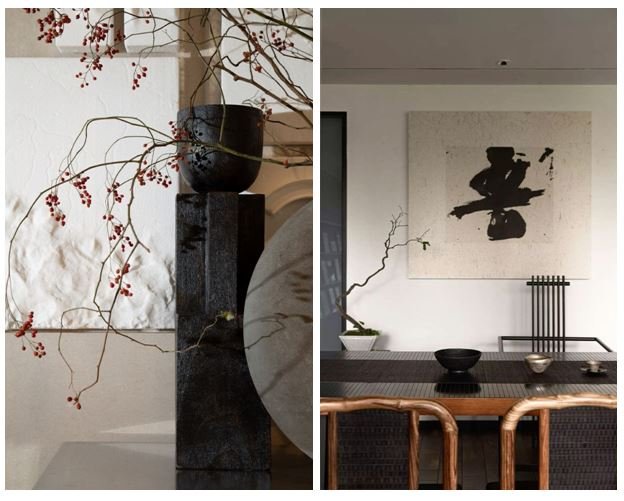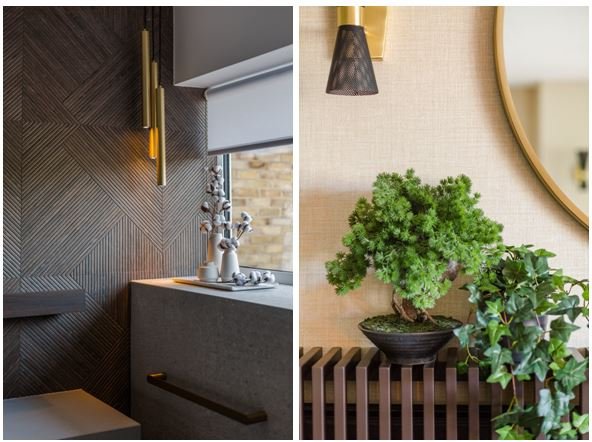The Ultimate Guide to Japanese Interior Design in Cambridgeshire: From Space Planning to Final Touches!
Welcome, design enthusiasts! In this article we explore further our ultimate favourite design style direction - Japanese Interior design and what it means when incorporating some influences into our designs.
Are you looking to bring a touch of Japanese interior design to your home in Cambridgeshire?
Look no further! This ultimate guide covers everything you need to know about bringing custom-designed interiors to your Cambridgeshire home, from space planning to the final touches. Whether you're looking to create a traditional Japanese interior, or a modern take on a classic look, this guide has all the information you need to get the perfect design. Learn how to use space planning and interior design to create the perfect ambience for your home!
Japanese influenced bedroom designed by Pinterior.space
Incorporating Japanese Design Principles for a Serene Home!
Incorporating Japanese design principles into your home can create a serene and calming atmosphere. Whether you're a homeowner in Cambridgeshire or a high-end interior designer, these design principles can be applied to any space. Japanese design is known for its emphasis on minimalism, natural elements, and harmony.
To create a serene home, start by focusing on simplicity. Avoid clutter and choose furniture and decor with clean lines. Opt for a neutral colour palette and natural materials like wood and stone. Incorporate elements of nature into your design, such as plants or a small indoor garden.
Consider the layout of your space and how it promotes flow and functionality. Japanese design often emphasizes an open floor plan and multi-purpose rooms. Incorporate sliding doors or screens to separate areas and create flexibility in your space.
Lighting is also crucial in Japanese design. Use soft, natural light sources like paper lanterns or floor lamps to create a warm and inviting ambience.
Incorporating Japanese design principles into your home can transform it into a peaceful sanctuary. With a focus on simplicity, natural elements, and harmony, you can create a serene and calming space that promotes relaxation and tranquillity. Whether you're looking for living room interior design or home interior design in Cambridge, these principles can be adapted to any space. So, embrace the beauty of Japanese design and create your own serene oasis at home.
Creating Balance with Natural Elements!
When it comes to creating a balanced and harmonious space, incorporating natural elements is key in Japanese interior design. By bringing in elements from nature, you can add a sense of tranquillity and serenity to your home in Cambridgeshire. Whether you're a high-end interior designer or simply looking for living room interior design ideas, integrating natural elements can transform your space.
One way to achieve balance with natural elements is through the use of plants. Adding indoor plants can not only bring a touch of greenery to your home but also help purify the air and create a sense of calm. Consider incorporating bamboo, bonsai trees, or even a small indoor garden for a true Japanese-inspired feel.
Another way to create balance is through the use of natural materials. Incorporate wood accents or furniture pieces to bring warmth and texture to your space. Choose furniture made from sustainable materials and opt for natural fabrics for upholstery.
By creating a balance with natural elements, you can transform your space into a calming oasis that promotes relaxation and harmony. Whether you're looking for home interior design in Cambridge or simply want to enhance the serenity of your living room, embracing natural elements is the way to go.
Japanese natural elements - designed by Pinterior.space
Furniture Selection and Arrangement!
When it comes to incorporating Japanese interior design into your home in Cambridgeshire, furniture selection and arrangement play a crucial role. Whether you're a high-end interior designer or looking for living room interior design ideas, the right furniture can transform your space into a serene oasis.
In Japanese design, simplicity and functionality are key. Opt for furniture with clean lines and a minimalist aesthetic. Avoid bulky pieces that can clutter your space and disrupt the sense of tranquillity. Instead, choose furniture that serves a purpose and complements the overall design scheme.
Consider the layout of your space and how the furniture will promote flow and functionality. Japanese design often emphasizes an open floor plan and multi-purpose rooms. Use furniture placement to create designated areas and define different zones within your home.
Incorporate traditional Japanese furniture pieces, such as low-profile seating and floor cushions, to add authenticity to your design. Mix and match furniture styles and materials to create visual interest and texture.
Whether you're looking for living room interior design or home interior design in Cambridge, thoughtful furniture selection and arrangement can bring the essence of Japanese design into your home, creating a space that is both beautiful and functional.
Japanese influences in furnishings - Designed by Pinterior.space
Lighting as a Key Element in Japanese Design!
When it comes to creating a truly authentic Japanese interior design, lighting is a key element that should not be overlooked. In Japanese design, lighting serves a dual purpose - not only does it provide illumination, but it also plays a crucial role in setting the mood and creating an ambience.
Incorporating soft, natural light sources is essential for achieving the serene and calming atmosphere that Japanese interiors are known for. Paper lanterns, floor lamps, and diffused lighting fixtures are all popular choices. The warm glow they emit adds a sense of warmth and cosiness to any space.
To further enhance the Japanese aesthetic, consider using adjustable lighting options that allow you to create different levels of brightness and shadow. This can help create a peaceful and tranquil ambience that is perfect for relaxation and meditation.
By carefully selecting and arranging your lighting fixtures, you can create a beautiful and soothing atmosphere in your home. So, embrace the importance of lighting as a key element in Japanese design and let it illuminate your space with serenity and tranquillity.
Japanese influences in Lighting - designed by Pinterior.space
Simplicity and Order in Japanese Interior Design!
In Japanese interior design, simplicity and order are fundamental principles that contribute to the serene and harmonious atmosphere of a space. The concept of simplicity revolves around minimalism, where unnecessary clutter and excessive decoration are avoided. Instead, clean lines, open spaces, and a focus on functionality are embraced. This creates a sense of calm and tranquillity that allows for relaxation and mindfulness.
Order is also an essential element in Japanese interior design. It refers to the careful arrangement and organization of objects and furniture in a space. Every item has its place, and there is a deliberate intention behind its placement. By creating order, the space becomes more visually pleasing and balanced.
To incorporate simplicity and order into your Japanese-inspired interior design in Cambridgeshire, focus on de-cluttering and keeping only essential items. Use storage solutions to hide away belongings that are not in use. Keep furniture arrangements clean and uncluttered, allowing for easy movement and flow within the space. Embrace simplicity in colour schemes and materials, opting for natural hues and minimalist finishes.
By embracing simplicity and order, you can create a Japanese-inspired interior that promotes a sense of peace and serenity in your home.
Japanese inspired fabric - Designed by Pinterior.space
Incorporating Textures and Patterns for Visual Interest!
Incorporating textures and patterns into your Japanese-inspired interior design can add depth, visual interest, and personality to your space. By carefully selecting and layering different textures, you can create a tactile experience that invites touch and exploration. Consider adding elements such as woven textiles, natural fibers, and textured wallpapers to introduce a sense of warmth and richness to your design. Incorporating patterns, such as traditional Japanese motifs or geometric shapes, can also add visual interest and create focal points within your space.
Whether you choose to incorporate textures and patterns through rugs, cushions, or wallpaper, be sure to keep the overall aesthetic balanced and cohesive. By incorporating these elements, you can create a truly unique and visually stunning Japanese-inspired interior design in Cambridgeshire that reflects your personal style and adds depth to your space. So, don't be afraid to experiment and have fun with textures and patterns to create a space that is as visually intriguing as it is serene.
https://www.janeclayton.co.uk/today-interiors-zen-garden-wallpaper-62-298962/Japanese inspired wallpaper - bedroom design by Pinterior.space
Our design services cover a wide range of spaces such as kitchens, bathrooms, bedrooms, living rooms, children's spaces, offices, hallways and dining rooms. Whether you're looking for a complete redesign or a simple refresh, we have the expertise to help you create a space that reflects your style and meets your needs.
At our interior design studio, our passion is creating beautiful interiors that reflect our clients' unique tastes and requirements. Let us help you bring your vision to life!
Contact us today to via the form or give us a call on 07968 449090 to get started. Don’t forget to take a look at our previous projects so you can get a better idea of the high-level of standard we offer.
You can also find and follow us on Facebook, Pinterest and Instagram.







